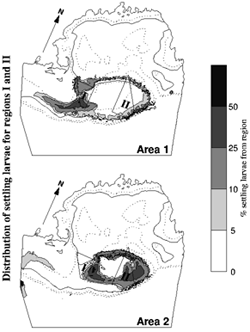GLOBEC Technology Transfer:
Biological-Physical Modelling of
Sea Scallop Fishery Closures
- Craig V.W. Lewis; Numerical Methods Lab, Dartmouth College, Hanover, NH
Numerical models developed for the Northwest Atlantic GLOBEC circulation and hindcasting research are beginning to see application in areas of fisheries research well beyond the initial focus on Cod and Calanus. In a collaboration between the National Marine Fisheries Service, the University of Maryland, and Dartmouth College, researchers are using climatological circulation models with simple population and behavioral models to estimate transport and recruitment of Sea Scallop (Placopecten magellanicus) larvae on Georges Bank. This work synthesizes the results of ongoing modelling studies focused on hydrodynamics (Naimie, 1996) and Calanus (Miller, 1998).
 Map of percentage of larvae in a given region that were spawned in Closed Areas I (top) and II (bottom). |
The simulations identify source and sink regions for the areas of fishery closure, and provide simple predictions of their long-term effects on bank-wide population dynamics. Individual scallop larvae are transported for 40 days using a two-dimensional vertical average of the top 25 meters of Dartmouth's GLOBEC Georges Bank climatological circulation archive. These larvae settle, grow, and spawn further generations, allowing patterns of population density to develop. The rate of population growth and relative sizes of the population in closed and open areas is then used to compare the effects of the closures under various levels of fishing pressure and background mortality. Initial results have been presented at the 1999 Santa Fe ASLO meeting, and summarized for a March Sea Scallop Working Group meeting in Buzzards Bay, MA.
The results provide some insight into how these closed areas function. The climatological flowfields suggest that the two closed areas feed larvae to large regions of the bank; they also tend to resupply themselves due to interaction of the 40-day planktonic duration and the anticyclonic gyre (see Figure). In linear population models, reduction of mortality in closed areas has an immediate effect on population levels within the protected area, and the unprotected areas benefit in turn from the increased supply of larvae flowing to them.
Reduction of fishing mortality within the fishable regions has a dramatic effect on the overall distribution and population growth rate of scallops on the bank. As might be expected, these effects are most strongly felt in those cases where total mortality is assumed to be high and where mortality is believed to be dominated by fishing mortality. These results provide a sense for how some of the products of GLOBEC research may begin to flow into the field of applied fishery management. While the work is still in its infancy, the reception has exceeded expectations. Requests for extensions and clarifications of the work have arrived from fishermen, aquaculturists, scientists and managers. The number and nature of these requests (some of which exceed our current capability) indicates a robust demand for continued research and development of reliable management-oriented models.
These models represent an initial foray into a field of work that will require extensive further research. Significant refinement is necessary in a number of areas before even a qualitative predictive system can be contemplated. Inclusion of density dependence, predation, interannual variability and larval behavior are necessary to increase our understanding of this system. On the other hand, some insight into the dynamics of the system can be gained from the simple models presented here ....
REFERENCES:
RELATED LINKS:
Please address any comments, suggestions or questions to: GLOBEC Webmaster